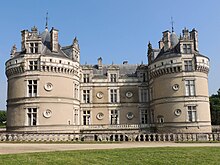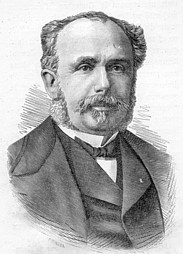History of Le Lude
The spur of the Vaux camp and the Cherré site, both located a few kilometers east of Le Lude, demonstrate the region's continued dynamism from the Bronze Age to Antiquity.
The town of Le Lude experienced a new period of growth and prosperity during the Renaissance era, thanks to the efforts of its lord, Jean Daillon [fr], who undertook the castle restoration from its ruins.
Following the Restoration, it was repeatedly affected by unrest related to the Chouannerie, with the royalist troops of Bernard de la Frégeolière [fr] seizing control of the area on two occasions.
Similarly, the deportation of several young people who resisted compulsory work service (STO) triggered a spontaneous protest against the occupying forces.
[11] Additionally, three kilometers north of Le Lude, on a hillside overlooking the Loir, the remains of a Gallo-Roman villa have been unearthed in the vicinity of the Grifferie castle [fr].
[d 1][a 3] Given its pivotal location at the border of Maine, Anjou, and Touraine, the site of Le Lude assumed particular significance, leading to the erection of the "Fort de la Motte" on the left bank of the Loir.
Surprised by the attack of the Duke of Brittany and lacking the necessary troops to sustain the fight, Fulk Nerra immediately submitted and returned the men and property he had seized.
During the initial assault, the English filled the moats with wood piled up in front of the ramparts but were repelled, with notable assistance from Jean III of Bueil [fr].
In May 1545, François I elevated the seigneury of Le Lude to the status of a county and,[22][23] in 1675, Henry de Daillon [fr], lieutenant-general of the king's armies, was granted the duchy-peerage.
An ecclesiastic from a noble family of Le Lude, he acquired buildings located at the city gates, previously occupied by a community of Clarisse nuns.
[a 11] On April 16, 1640, Timoléon de Daillon, the lord of Le Lude, transferred ownership of a house situated on the outskirts of the town[Note 2] to the Recollect monks, to establish a convent there.
The tanners of Le Lude played a significant role in the development of the fair in the hamlet of Raillon, where trade in hides with merchants from across Western France was conducted.
[a 14] In the final decades of the 18th century, the Marquise de la Vieuville, the heir to the castle, undertook a series of substantial modifications to the residence, including the construction of the northeast facade, which faces the spur and the Loir, in a neoclassical style.
On October 10, 1790, the Department Directory issued an order transferring the annual fair from the hamlet of Raillon to the newly constructed Place du Mail in Le Lude.
On December 10, 1793, while the insurgents had occupied La Flèche for three days, members of the municipal council of Le Lude sought refuge in Coulongé.
After the signing of the peace treaty by Count Bourmont at the beginning of February, Bernard de la Frégeolière maintained his troops in Le Lude for some time.
[32][33] In 1813, Bernard de la Frégeolière clandestinely organized two companies of one hundred men each between Sarthe and Maine-et-Loire, under the name of "Nouveaux-Nés", to gather draft dodgers and hinder tax collection.
On June 9, the royalist troops, led by General of Ambrugeac [fr] and Bernard de la Frégeolière, captured the town of Le Lude.
[a 20][e 1] The Malidor mill, which had previously been used for the production of flour and the tanning of animal hides until 1893, was subsequently converted into a hydroelectric power plant,[e 2] thereby supplying the town with electricity.
[b 2] Industry concentrated along the Loir River, particularly in the bridge district, where the Joly tannery, Coiffard dairy, a boat-making workshop, and a laundry boat were located.
[b 4] The British military also initiated the construction of a provisional airfield to the south of the town, requisitioning agricultural land and demolishing buildings on the Bel-Air farm.
Initially situated on the ground floor of the town hall and subsequently in the Hôtel du Bon Laboureur, the center could not accommodate the influx of refugees, who were occasionally housed in nearby farm barns and sheds.
[b 10] On February 16, 1943, approximately 200 young people were summoned to the town hall for registration under the recently enacted law establishing compulsory work service.
[b 12] On March 3, 1944, at a late hour in the morning, an act of sabotage perpetrated by local resistance fighters resulted in the detonation of a German munitions train at Le Lude station.
The German troops placed them in the vacant buildings of the Paul Marétheu shoe factory, situated by the Ris-Oui stream on the road to La Flèche.
[45] The women were assigned to excavate tuffeau in the mushroom caves of Luché-Pringé, situated opposite the Pilier farm, to store munitions and housing V1 missile assembly lines.
In the meantime, they were engaged in the repair of the departmental road from Port des Roches to the mushroom caves, a 2.5-kilometer section that had been damaged by the passage of trucks transporting materials.
On September 10, they joined other volunteers in Le Mans to form the 1st Company of the 8th FFI Battalion,[46][b 18] which fought in the Saint-Nazaire pocket until the German forces surrendered on May 11, 1945.
In 1958, Princess Pia-Maria of Orléans-Braganza, widow of Count René de Nicolaÿ, commissioned the creation of one of France's first sound and light shows at the château.
These collapses are attributed to the numerous underground tuffeau stone extraction galleries, which have been utilized since the 16th century for the construction of residential buildings and the castle in Le Lude.











